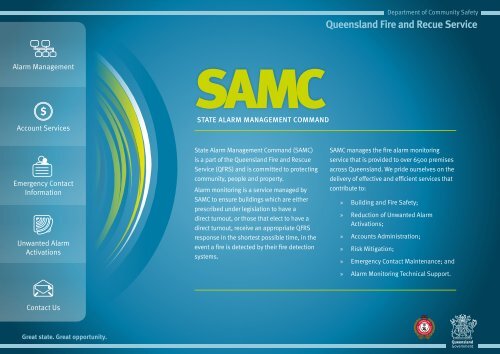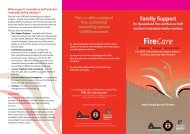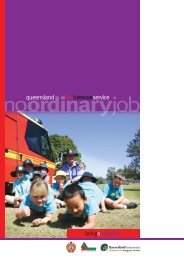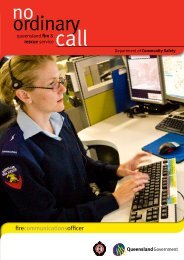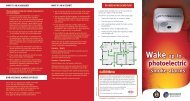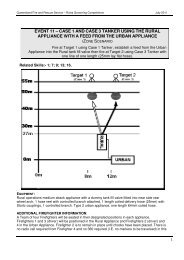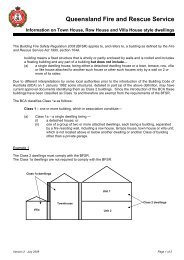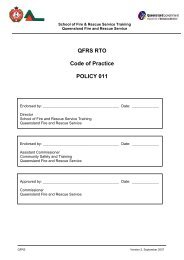Alarm Monitoring - Queensland Fire and Rescue Service
Alarm Monitoring - Queensland Fire and Rescue Service
Alarm Monitoring - Queensland Fire and Rescue Service
- No tags were found...
Create successful ePaper yourself
Turn your PDF publications into a flip-book with our unique Google optimized e-Paper software.
Department of Community Safety<br />
<strong>Queensl<strong>and</strong></strong> <strong>Fire</strong> <strong>and</strong> Recue <strong>Service</strong><br />
<strong>Alarm</strong> Management<br />
Account <strong>Service</strong>s<br />
SAMC<br />
STATE ALARM MANAGEMENT COMMAND<br />
Emergency Contact<br />
Information<br />
Unwanted <strong>Alarm</strong><br />
Activations<br />
State <strong>Alarm</strong> Management Comm<strong>and</strong> (SAMC)<br />
is a part of the <strong>Queensl<strong>and</strong></strong> <strong>Fire</strong> <strong>and</strong> <strong>Rescue</strong><br />
<strong>Service</strong> (QFRS) <strong>and</strong> is committed to protecting<br />
community, people <strong>and</strong> property.<br />
<strong>Alarm</strong> monitoring is a service managed by<br />
SAMC to ensure buildings which are either<br />
prescribed under legislation to have a<br />
direct turnout, or those that elect to have a<br />
direct turnout, receive an appropriate QFRS<br />
response in the shortest possible time, in the<br />
event a fire is detected by their fire detection<br />
systems.<br />
SAMC manages the fire alarm monitoring<br />
service that is provided to over 6500 premises<br />
across <strong>Queensl<strong>and</strong></strong>. We pride ourselves on the<br />
delivery of effective <strong>and</strong> efficient services that<br />
contribute to:<br />
»»<br />
Building <strong>and</strong> <strong>Fire</strong> Safety;<br />
»»<br />
Reduction of Unwanted <strong>Alarm</strong><br />
Activations;<br />
»»<br />
Accounts Administration;<br />
»»<br />
Risk Mitigation;<br />
»»<br />
Emergency Contact Maintenance; <strong>and</strong><br />
»»<br />
<strong>Alarm</strong> <strong>Monitoring</strong> Technical Support.<br />
Contact Us<br />
Great state. Great opportunity.
<strong>Alarm</strong> Management<br />
<strong>Alarm</strong> Management<br />
Account <strong>Service</strong>s<br />
Emergency Contact<br />
Information<br />
Unwanted <strong>Alarm</strong><br />
Activations<br />
Contact Us<br />
The <strong>Alarm</strong> Management unit is responsible for<br />
providing contractual <strong>and</strong> technical support to<br />
monitored alarm premises.<br />
This is done through:<br />
• <strong>Alarm</strong> Connections;<br />
• <strong>Alarm</strong> Disconnections;<br />
• Transfer of Ownership;<br />
• <strong>Alarm</strong> Isolations;<br />
• <strong>Alarm</strong> Signalling Equipment (ASE) Fault<br />
Diagnosis;<br />
• ASE Technical Support; <strong>and</strong><br />
• Responding to enquiries arising from the alarm<br />
industry <strong>and</strong> from our existing 6500 monitored<br />
premises.<br />
In addition, the Contract <strong>and</strong> <strong>Alarm</strong> team also work<br />
with <strong>Fire</strong> Communications <strong>and</strong> their support units<br />
to ensure best alarm management practices are<br />
implemented, managed <strong>and</strong> adhered to.<br />
The Contract <strong>and</strong> <strong>Alarm</strong> team also work closely with<br />
the fire protection alarm industry providing solutions<br />
for alarm monitoring. Development in this area has<br />
seen alarm technicians accountable for their st<strong>and</strong>ard<br />
of work, the alarm industry <strong>and</strong> QFRS taking a more<br />
proactive approach toward Community Safety, timely<br />
key lodgment <strong>and</strong> relevant turnout information,<br />
compliance <strong>and</strong> consistency to processes <strong>and</strong> Risk<br />
Management.<br />
>> Connections<br />
>> Disconnections<br />
>> Technical Support<br />
>> Emergency Contact Information<br />
>> Unwanted <strong>Alarm</strong> Activations<br />
>> Transfer of Ownership
<strong>Alarm</strong> Management<br />
<strong>Alarm</strong> Management<br />
>> Connections<br />
Do all premises need to be connected directly to the brigade<br />
Account <strong>Service</strong>s<br />
<strong>Fire</strong> <strong>Alarm</strong> <strong>Monitoring</strong> for a premises may be prescribed under legislation through the Building Code of Australia.<br />
If your premises is deemed to require monitoring under the code, failure to be monitored may make the building<br />
unlawful to occupy.<br />
How does a premises owner apply for brigade monitoring<br />
Emergency Contact<br />
Information<br />
The premises owner will need to consult with a <strong>Fire</strong> Protection <strong>Monitoring</strong> Company (FPC) to ensure the current fire<br />
alarm system is compliant with relevant Australian St<strong>and</strong>ards to obtain direct brigade monitoring. The QFRS have<br />
minimum requirements for this regardless of whether the premises is prescribed or not. If you do not have a fire<br />
alarm system in place, you may need to consult with a FPC or <strong>Fire</strong> Engineer to provide you with further advice.<br />
What is the cost for brigade monitoring<br />
Refer to the QFRS Schedule of Charges section.<br />
Unwanted <strong>Alarm</strong><br />
Activations<br />
>> How to make an application<br />
Contact Us<br />
>> Schedule of Charges
<strong>Alarm</strong> Management<br />
<strong>Alarm</strong> Management<br />
>> Connections >> How to make an application<br />
Making an application for a fire detection system to be monitored by the QFRS<br />
Account <strong>Service</strong>s<br />
Emergency Contact<br />
Information<br />
Complete <strong>and</strong> submit a Notice of Pending Connection. Ensure all sections have been filled in with detailed<br />
information.<br />
Payment is required at the time of application for the connection fee (refer to schedule of charges).<br />
Payment can be made either by cheque or via invoice. If an invoice is required you will also need to provide billing<br />
information.<br />
Relevant documents will be provided to the premises owner, these documents include:<br />
• <strong>Alarm</strong> Management Agreement;<br />
• Emergency Contact Form;<br />
• Key Lodgment Form.<br />
Return completed documentation, an application cannot proceed until all documentation is returned.<br />
Unwanted <strong>Alarm</strong><br />
Activations<br />
Contact Us<br />
>> Schedule of Charges
<strong>Alarm</strong> Management<br />
Account <strong>Service</strong>s<br />
Emergency Contact<br />
Information<br />
Unwanted <strong>Alarm</strong><br />
Activations<br />
Contact Us<br />
<strong>Alarm</strong> Management<br />
>> Schedule of Charges<br />
ALARM MANAGEMENT CHARGES $ GST TOTAL<br />
ALARM MANAGEMENT CHARGE<br />
Charged for each connection as of 1 July each year. Paid in advance.<br />
MULTIPLE ALARM CHARGE<br />
Charged for each additional connection at the same gazetted address. Paid in advance.<br />
SUB-PANEL CHARGE<br />
Charged for each sub-premises/sub-panel at the one premises. Paid in advance.<br />
$2540.10 $254.00 $2794.10<br />
$1987.90 $198.75 $2186.65<br />
$662.60 $66.25 $728.85<br />
MONTHLY ALARM MANAGEMENT PRO-RATA CHARGES $ GST TOTAL<br />
MONTHLY ALARM MANAGEMENT CHARGE<br />
<strong>Alarm</strong> connected mid-year will be charged at pro-rata rate from date of connection.<br />
MONTHLY MULTIPLE ALARM CHARGE<br />
Multiple alarm connected mid-year will be charged at pro-rata rate from date of connection.<br />
MONTHLY SUB-PANEL CHARGE<br />
Sub-premises/sub-panel connected mid-year will be charged at pro-rata rate from date of connection.<br />
CONNECTION, DISCONNECTION AND TRANSFER CHARGES<br />
* These charges are non refundable<br />
FIRE ALARM CONNECTION CHARGE *<br />
To be paid with an application for the connection of fire alarm system.<br />
FIRE ALARM DISCONNECTION CHARGE *<br />
To be paid with an application for the disconnection of a fire alarm system.<br />
FIRE ALARM TRANSFER CHARGE *<br />
Paid when an alarm account is transferred from an existing premises owner/tenant to a new premises owner.<br />
UNWANTED ALARM RESPONSE CHARGES<br />
*Unwanted <strong>Alarm</strong> Activation charges are GST exempt.<br />
$211.60 $21.15 $232.75<br />
$165.65 $16.55 $182.20<br />
$55.20 $5.50 $60.70<br />
$ GST TOTAL<br />
$298.80 $29.85 $328.65<br />
$298.80 $29.85 $328.65<br />
$298.80 $29.85 $328.65<br />
$ GST TOTAL<br />
1ST unwanted alarm response (inside the Urban District Boundary) within any continuous 60 day period* No Charge $0.00 No Charge<br />
2nd <strong>and</strong> subsequent unwanted alarm response(s) within any continuous 60 day period - or all unwanted<br />
alarm response(s) outside the Urban District Boundary*<br />
QFRS CONTRACTOR SERVICE CALL OUT CHARGES<br />
*Charged for non-warranty issues<br />
SERVICE CALL OUT CHARGE *<br />
Covers the first 30 mins of labour then $90 per hour thereafter.<br />
AFTER HOURS SERVICE CALL OUT CHARGE *<br />
Covers the first hour of labour then $135 per hour thereafter.<br />
$1056.00<br />
per alarm<br />
$0.00 $1056.00<br />
per alarm<br />
$ GST TOTAL<br />
$155.00 $15.50 $170.50<br />
$380.00 $38.00 $418.00
<strong>Alarm</strong> Management<br />
<strong>Alarm</strong> Management<br />
>> Transfer of Ownership<br />
Invoicing requirements<br />
Account <strong>Service</strong>s<br />
Emergency Contact<br />
Information<br />
It is a requirement of QFRS that the owner of a monitored premises is invoiced for all alarm management<br />
charges as per Section 144, <strong>Queensl<strong>and</strong></strong> <strong>Fire</strong> <strong>and</strong> <strong>Rescue</strong> <strong>Service</strong> Act (1990).<br />
As an owner of monitored premises you may require the occupier or tenant to be responsible for paying the<br />
alarm management charge. SAMC can establish an annexure to the <strong>Alarm</strong> Management Agreement (AMA) to<br />
allow for the deviation from the usual QFRS policy of invoicing the premises owner for services rendered in fire<br />
alarm monitoring.<br />
Building compliance<br />
The premises owner is responsible for compliance with the Building Code of Australia, including the<br />
requirement of specified classes of buildings to have a fire alarm monitoring system which is connected to the<br />
fire brigade or fire dispatch centre.<br />
Selling a monitored premises<br />
Unwanted <strong>Alarm</strong><br />
Activations<br />
If you have sold or are currently selling premises that is monitored by QFRS, you are required to contact QFRS to<br />
arrange a change of ownership. Ideally, this process can be conveyed via your legal representative. If the sale<br />
has already occurred, contact SAMC to organise for Transfer of Ownership documentation to be forwarded to the<br />
new premises owner.<br />
Contact Us
<strong>Alarm</strong> Management<br />
<strong>Alarm</strong> Management<br />
>> Disconnections<br />
Intention to discontinue fire alarm monitoring<br />
Account <strong>Service</strong>s<br />
Should QFRS be advised of the expressed intention to discontinue fire alarm monitoring for your premises, it will be<br />
necessary for the premises owner to complete an Application for Disconnection. This application <strong>and</strong> supporting<br />
documentation will be forwarded to QFRS Community Safety Operations for assessment.<br />
Disconnection considerations<br />
To avoid any confusion <strong>and</strong> prevent any delays in the processing of an application please note the following points:<br />
Emergency Contact<br />
Information<br />
Unwanted <strong>Alarm</strong><br />
Activations<br />
• <strong>Fire</strong> <strong>Alarm</strong> <strong>Monitoring</strong> for premises may be prescribed under the Building Code of Australia or the <strong>Queensl<strong>and</strong></strong><br />
Development Code (QDC). In this event, failure to be monitored may make the building unlawful to occupy. It<br />
will be necessary for a building certifier to complete the relevant section of the application, or a demolition<br />
permit issued by your local council must be provided;<br />
• It would be considered prudent to take into consideration any impact this may have on insurance for the<br />
building <strong>and</strong> consult the service provider before initiating disconnection. Please also consider the safety of<br />
the occupants of the building before applying for removal of the alarm signalling device.<br />
Contact Us
<strong>Alarm</strong> Management<br />
Emergency Contact Information<br />
Emergency contact requirements<br />
It is a requirement of the owner/occupier to ensure all emergency contact information is<br />
maintained <strong>and</strong> up to date at all times.<br />
Account <strong>Service</strong>s<br />
In the event of a fire alarm activation or other emergency, QFRS Emergency Dispatchers or Technical<br />
Support may need to notify the authorised representatives of a monitored premises - individuals<br />
who can be contacted 24 hours a day <strong>and</strong> have access to the monitored premises.<br />
We may also need to make contact regarding other alarm management matters, such as <strong>Alarm</strong><br />
Signalling Equipment (ASE) or system faults, or account queries. We collect this information via an<br />
Emergency Contacts form.<br />
Emergency Contact<br />
Information<br />
Updating your details with us<br />
Request an Update Emergency Contacts Form by entering <strong>and</strong> sending us the details in the form<br />
below, or you can contact us directly.<br />
FCA Number (if known):<br />
Unwanted <strong>Alarm</strong><br />
Activations<br />
Premises Name (if known):<br />
Premises Address:<br />
Contact Name:<br />
Contact Us<br />
Phone Number:<br />
>> Send request
<strong>Alarm</strong> Management<br />
<strong>Alarm</strong> Management<br />
>> Technical Support<br />
Maintaining the <strong>Fire</strong> <strong>Alarm</strong> System<br />
Account <strong>Service</strong>s<br />
It is important to ensure your fire protection company undertakes regular maintenance checks of your fire indicator<br />
panel as per the Australian St<strong>and</strong>ards. Maintaining your alarm system not only reduces equipment failure <strong>and</strong><br />
unwanted alarm activations, but is a requirement under the <strong>Fire</strong> <strong>and</strong> <strong>Rescue</strong> <strong>Service</strong> Act 1990.<br />
Testing<br />
Your fire alarm system is to be tested monthly by an appropriately qualified person, in accordance with Australian<br />
St<strong>and</strong>ard 1851.<br />
Emergency Contact<br />
Information<br />
Under Australian St<strong>and</strong>ards a compliant test can only be received through <strong>Fire</strong>NET via an ASE configured to Test<br />
Mode. To ensure compliant testing of an ASE, the technician must configure the ASE to Test Mode on-site via an ASE<br />
key.<br />
Panel Replacement or Relocation<br />
Unwanted <strong>Alarm</strong><br />
Activations<br />
The ASE remains the property of QFRS <strong>and</strong> operates under warranty. This warranty protects you as our customer<br />
against issues arising with the ASE <strong>and</strong> ensures compliance with Australian St<strong>and</strong>ards <strong>and</strong> legislative requirements.<br />
If during alarm maintenance or building work, the ASE is required to be replaced or relocated, QFRS are to be<br />
engaged. Generally your fire protection company will operate on your behalf, however to maintain the warranty of<br />
the ASE, a QFRS contractor is required to attend site <strong>and</strong> commission the ASE to the <strong>Fire</strong> <strong>Monitoring</strong> Centre.<br />
Charges do apply for this service in accordance with our Schedule of Charges.<br />
Contact Us<br />
>> What is an ASE<br />
>> Isolating the ASE
<strong>Alarm</strong> Management<br />
<strong>Alarm</strong> Management<br />
>> Technical Support >> What is an ASE<br />
<strong>Alarm</strong> Signalling<br />
Equipment<br />
Account <strong>Service</strong>s<br />
INPUT<br />
1<br />
2<br />
3<br />
4<br />
LOCATION<br />
ALARM SYSTEM STATUS<br />
ALARM<br />
FAULT<br />
ISOLATE<br />
ASE INPUT STATUS<br />
WIRING FAULT<br />
ISOLATE MODE<br />
TEST MODE<br />
Emergency Contact<br />
Information<br />
ASE STATUS<br />
RADIO<br />
PHONE<br />
ETHERNET<br />
SBUS<br />
POWER<br />
FAULT<br />
<strong>Alarm</strong> System Test Procedure<br />
Action<br />
TEST MODE<br />
1 Insert Key<br />
Off<br />
2 Select Input(s) Off<br />
3 Select Mode Flash ⇒ On<br />
4 Activate <strong>Alarm</strong> On<br />
5 Reset <strong>Alarm</strong><br />
On<br />
6 Remove Key Flash ⇒ Off<br />
<strong>Alarm</strong> System Isolate Procedure<br />
Action<br />
1 Insert Key<br />
2 Select Input(s)<br />
3 Select Mode (twice)<br />
ISOLATE MODE<br />
1 Off<br />
2 Off<br />
3 Flash ⇒ On<br />
ALARM<br />
Off<br />
Off<br />
Off<br />
Slow Flash ⇒ On<br />
Slow ⇒ Rapid Flash<br />
Rapid Flash ⇒ Off<br />
Normal Operation RADIO, PHONE, POWER On Steady<br />
Unwanted <strong>Alarm</strong><br />
Activations<br />
INPUT<br />
MODE<br />
For all alarm queries 1800 449 992<br />
Contact Us<br />
The <strong>Alarm</strong> Signalling Equipment (ASE) is the device (little red box) inside your fire panel which enables the<br />
monitoring of your buildings fire equipment by QFRS. The ASE will send signals to the monitoring centre to<br />
advice of any changes in status of your fire equipment e.g. activations <strong>and</strong> panel faults. <strong>Fire</strong> <strong>Alarm</strong> <strong>Monitoring</strong><br />
for premises may be prescribed under the Building Code of Australia. Premises which meet these criteria require<br />
direct brigade monitoring via the ASE device.
<strong>Alarm</strong> Management<br />
<strong>Alarm</strong> Management<br />
>> Technical Support >> Isolating the ASE<br />
Isolating the ASE<br />
Account <strong>Service</strong>s<br />
Pursuant to Section 104D of the Building Code of Australia, it is prescribed that fire safety alarm<br />
monitoring is to be maintained at all times.<br />
For advice on risk mitigation, please contact your <strong>Fire</strong> Warden or fire protection company.<br />
Isolation considerations<br />
It is important to note the following information:<br />
Emergency Contact<br />
Information<br />
Unwanted <strong>Alarm</strong><br />
Activations<br />
• It is the premises owner/occupier’s responsibility to ensure the fire detection <strong>and</strong> alarm<br />
system is connected to the <strong>Fire</strong> <strong>Alarm</strong> <strong>Monitoring</strong> Centre at all times, excepting only such<br />
periods when maintenance or repairs are being undertaken;<br />
• If at any stage isolation of the ASE is required the owner/occupier must mitigate risk to an<br />
equivalent or higher st<strong>and</strong>ard as an unimpaired monitored alarm system; <strong>and</strong><br />
• Isolation requests over a certain period of time, or on a daily basis, will require QFRS<br />
involvement.<br />
Contact Us
<strong>Alarm</strong> Management<br />
Account <strong>Service</strong>s<br />
The Account Management unit delivers a range of invoicing <strong>and</strong> receivables management services.<br />
Account <strong>Service</strong>s<br />
Account services endeavours to provide exceptional client services whilst providing a high<br />
st<strong>and</strong>ard of customer service <strong>and</strong> a strong culture of compliance with regard to legislation <strong>and</strong><br />
regulations that govern the QFRS.<br />
Invoicing<br />
Emergency Contact<br />
Information<br />
Unwanted <strong>Alarm</strong><br />
Activations<br />
Account <strong>Service</strong>s produce <strong>and</strong> reconcile all requests for Tax Invoices on behalf of the QFRS, this<br />
area produces up to 1000 invoices each month for a number of QFRS business units including;<br />
Rural <strong>Fire</strong> <strong>Service</strong>, Training <strong>and</strong> Emergency Management, Operational Incidents <strong>and</strong> Community<br />
Safety.<br />
Debt Recovery<br />
Debt <strong>Service</strong>s provide a full range of receivables management services which range from<br />
receivables, legal <strong>and</strong> insolvency services. The debt team focus on providing the highest ethical<br />
st<strong>and</strong>ards <strong>and</strong> a strong culture of compliance with the laws <strong>and</strong> regulations governing our<br />
business.<br />
>> Schedule of Charges<br />
Contact Us<br />
>> Unwanted <strong>Alarm</strong> Activations
<strong>Alarm</strong> Management<br />
Unwanted <strong>Alarm</strong> Activations<br />
What is an Unwanted <strong>Alarm</strong><br />
An unwanted alarm as defined by the QFRS is:<br />
Account <strong>Service</strong>s<br />
“…an emergency alarm signalling at a time when the Commissioner is satisfied there was no emergency requiring<br />
the attendance of the <strong>Fire</strong> <strong>Service</strong>”.<br />
Why does QFRS charge the Premise Owner or Body Corporate<br />
Emergency Contact<br />
Information<br />
Unwanted <strong>Alarm</strong><br />
Activations<br />
QFRS charges for attendance at unwanted alarms to encourage building owners <strong>and</strong> occupiers to be continually<br />
proactive in managing fire alarm systems.<br />
Unwanted <strong>Alarm</strong> On-Charging:<br />
• Owners are responsible <strong>and</strong> accountable under the QFRS <strong>Alarm</strong> Management Agreement for the payment of<br />
services provided.<br />
• QFRS has no control over the practices adopted by premises owners in relation to on-charging costs for<br />
unwanted alarms.<br />
• The <strong>Queensl<strong>and</strong></strong> <strong>Fire</strong> <strong>and</strong> <strong>Rescue</strong> <strong>Service</strong> does not endorse ‘on-charging’ alarm attendance charges to<br />
tenants/occupants or contractors unless the third party has engaged in reckless or negligent behaviour.<br />
>> Schedule of Charges<br />
Contact Us<br />
>> Tips to prevent Unwanted <strong>Alarm</strong>s
<strong>Alarm</strong> Management<br />
Unwanted <strong>Alarm</strong> Activations<br />
>> Tips to prevent Unwanted <strong>Alarm</strong>s<br />
Helpful tips<br />
• Underst<strong>and</strong> your fire alarm system, particularly the type <strong>and</strong> location of detectors;<br />
Account <strong>Service</strong>s<br />
Emergency Contact<br />
Information<br />
• Manage work activities that produce dust, heat, smoke etc. to ensure a detector is not activated; <strong>and</strong><br />
• Ensure staff <strong>and</strong> visitors know your building is protected by an automatic fire alarm system <strong>and</strong><br />
provide these tips;<br />
--<br />
Ventilate steam <strong>and</strong> fumes away from smoke detectors, particularly from bathroom <strong>and</strong> kitchen<br />
areas;<br />
--<br />
Do not smoke near smoke detectors;<br />
--<br />
Do not direct aerosol spray at smoke detectors; <strong>and</strong><br />
- - Check toaster setting prior to use, do not walk away from a toaster that has been reset to further<br />
darken.<br />
Unwanted <strong>Alarm</strong><br />
Activations<br />
Contact Us
<strong>Alarm</strong> Management<br />
Contact Us<br />
State <strong>Alarm</strong> Management Comm<strong>and</strong><br />
<strong>Queensl<strong>and</strong></strong> <strong>Fire</strong> <strong>and</strong> <strong>Rescue</strong> <strong>Service</strong><br />
Po Box 620<br />
Albion Qld 4010<br />
Account <strong>Service</strong>s<br />
Emergency Contact<br />
Information<br />
Unwanted <strong>Alarm</strong><br />
Activations<br />
<strong>Alarm</strong> Management<br />
<strong>Alarm</strong> Connections, <strong>Alarm</strong> Disconnections, Transfer of<br />
Ownership, <strong>Alarm</strong> Management Charge (AMC) Invoicing<br />
• Phone: 1800 449 992<br />
• Fax: 07 3624 7901<br />
• Email: qfrs.alarms@dcs.qld.gov.au<br />
ASE Technical Support<br />
• Phone: 1800 289 785<br />
• Fax: 07 3624 7901<br />
• Email: samc.asesupport@dcs.qld.gov.au<br />
Data Management<br />
Emergency Contact Information<br />
• Phone: 1800 836 133<br />
• Fax: 07 3624 7901<br />
• Email: samc.data@dcs.qld.gov.au<br />
Account <strong>and</strong> Debt <strong>Service</strong>s<br />
Invoicing, Unwanted <strong>Alarm</strong> Activations, Debt Recovery<br />
• Phone: 1800 449 992<br />
• Fax: 07 3624 7901<br />
• Email: samc.account@dcs.qld.gov.au<br />
Contact Us<br />
www.fire.qld.gov.au


